

Introduction

• At a national level, the labour market is now showing sustained signs of softening in terms of labour demand – as the scale of vacancies continues to fall. This is beginning to manifest itself in increasing unemployment, although the rise is still marginal and also from a low level.
Economic inactivity remains a significant issue – both economically and politically – and underlying the fact that over 1-in-5 of working age people are currently classified as economically inactive is the proportion that are ill, either temporarily or over the longer-term.

• Locally, the Dorset labour market is showing similar characteristics – of a broadly ‘flatlining’ labour market. However, despite these softening conditions, wage growth remains robust –suggesting that recruitment and retention remains an issue for some employers.
Economic outlook

• Latest ONS Quarterly Economic figures illustrate the UK economy is emerging from a period of contraction, but it is still too early to understand whether this can be sustained.
Economic growth as measured by GDP grew by 0.6% in three months to March 24:
• Services output increased by 0.5% in March following an increase of 0.3% in February.
• Production output grew by 0.2% in March following growth of 1.0% in February.
• Construction output fell by 0.4% in March after falling by 2.0% in February.
Inflation continues to ease, the Consumer Price Index (CPI) standing at 3.2% in 12 months to March 24, down from 3.4% in February. Food inflation was a large contributor to this slowdown in price growth, with food inflation seeing its lowest annual rate since late 2021.

• In its recent World Economic Outlook, the International Monetary Fund (IMF) remains pessimistic about the growth prospects of the UK, particularly when compared to some of other industrialised economies. IMF now forecasts that the UK could see growth of +0.5% ) in 2024 , lower than its previous forecast. Whilst one of the lowest, it is marginally higher than in Germany. Some commentators do highlight that the IMF has consistently taken a pessimistic position on the UK economy, and it has not necessarily performed as badly as these forecasts.
• The latest NatWest Regional Purchasing Managers Index for the South-West indicates that confidence amongst businesses remains robust. Businesses remain broadly neutral in sentiment in terms of employment and the level of new business, but still hold a positive view in terms of future prospects. The GfK Consumer Confidence Index indicated that consumer confidence is broadly positive as we head into Spring, potentially reflecting the impact of lower inflation.
The labour market (UK)

• In their latest Report on Jobs, the Recruitment and Employment Confederation (REC) highlighted that vacancies data indicated that overall demand for workers has declined at the quickest rate since the start of 2021. The slowdown in hiring and redundancies drove an increase in candidate availability, while pay pressures cooled. Notably, permanent starters' pay increased at the slowest rate since 2021, while temp pay growth was also weak. However, they also note that the scale of advertised vacancies is still robust and could suggest a ‘soft landing for the UK labour market’.

• The Bank of England (BoE) reported that most firms are maintaining their current employment levels and the number of businesses reporting a reduction in head count remains low. Churn continues to decrease, reflecting uncertainty in the labour market and firms holding fewer vacancies. Recruitment difficulties continue to ease although some local labour markets and sectors such as engineering, software and manufacturing continue to struggle. The easing of inflation expectations, a looser labour market and affordability concerns continue to be cited as factors driving lower pay settlements this year. Firms also have no intention of making one-off payments. The feedback from businesses suggest that retention of employees is better, and that recruitment continues to get easier, although the labour market is still tight by historical standards. The BoE suggests that more evidence is emerging that average pay growth for 2024 will be lower than 2023 in line with its recent pay survey.
The labour market – UK vacancies and jobs
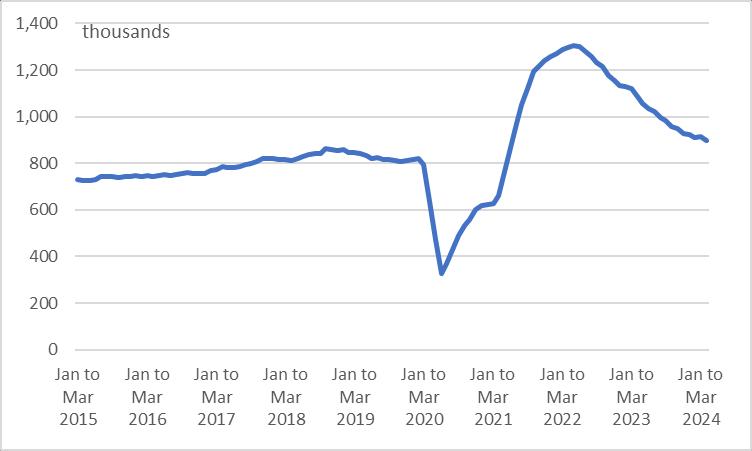

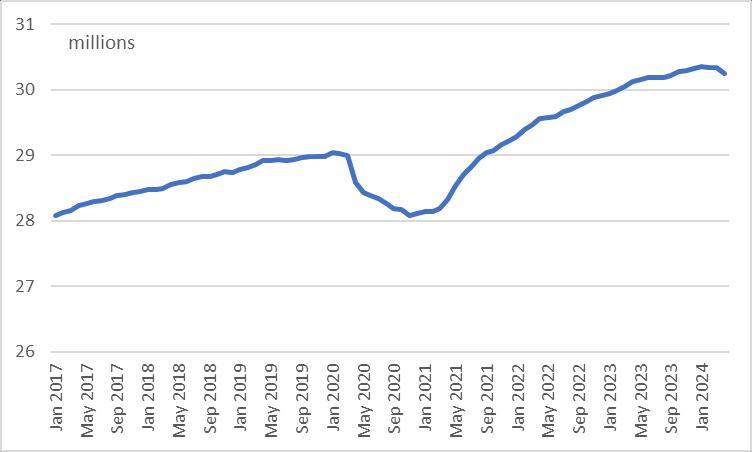

• Nationally, ONS reports an estimated 2.8% fall in the number of vacancies in the period Feb to Apr 24 compared to Nov 23 to Jan 24. Total vacancies were down by 188,000 (c17%) from a year ago, but still c102,000 above pre-pandemic levels.
• The industry with the largest fall was accommodation and food services, where vacancies were 29,000 than the same period in 2024.
• In January to March 2024, the number of unemployed people per vacancy was 1.6, up from 1.4 the previous quarter because of rising unemployment. Although this ratio remains low by historical standards it does show a slight loosening of the labour market as the number of vacancies fell against an increase in unemployment.
• In June 2023, UK workforce jobs fell to 36.7m - a fall of 153,000 since March 2023, with a record quarterly fall of 197,000 in self-employment jobs having the largest contribution. Employee jobs offset this slightly, increasing by 68,000 on the quarter.
*The number of jobs is not the same as the number of people in employment - a
Signs of softening – Dorset

• The scale of advertised vacancies has begun to fall across Dorset from historical highs. Over the first 3 months of 2024 there has been average of 7,950 advertised vacancies – lower than in 2023 but comparable to 2022. The important question is whether the scale of vacancies will continue to fall moving into the summer or, like as experienced in 2023, they increase during the summer months. summer and into early autumn. Given that vacancies fell at the end of 2023, this may mark a different demand environment with the hope that it will be a ‘soft landing’ for the local labour market. Many commentators had expected this labour market adjustment – pretty much since the pandemic and this adjustment may be overdue.
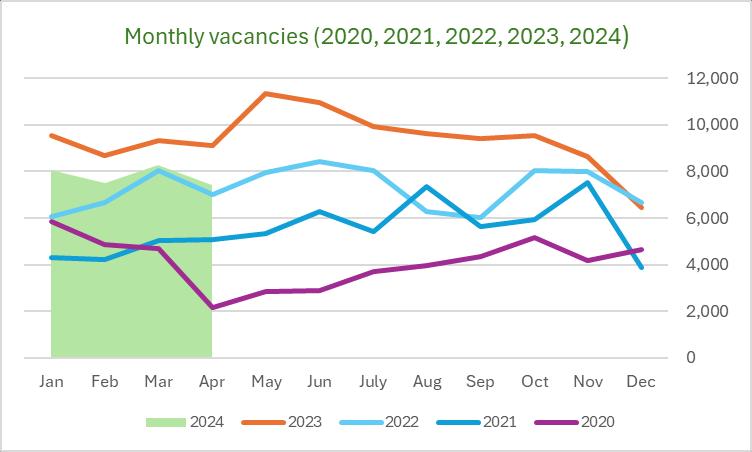


A fall in quarterly demand

• The aggregate vacancies advertised through the 3 months Jan-Mar of 2024 in Dorset was high by historical standards but lower than seen in 2023. When comparing the two local council areas, the fall in vacancies in absolute and proportional terms was more pronounced in BCP – falling by c17% from the same period the in 2023 – when compared to Dorset (fall of c7%). BCP still represents the location of highest vacancies – just below two-thirds of vacancies across the Dorset LEP area.
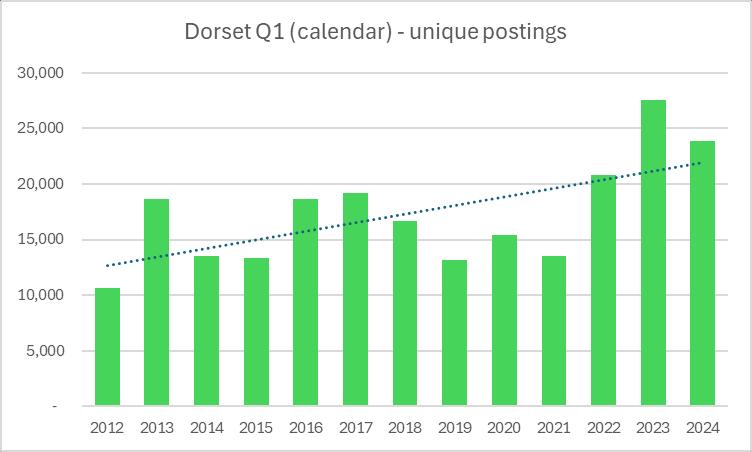


Unemployment remains low – for now

• Unemployment rates in Dorset (LEP) had declined continuously since the last quarter of 2021 when they reached 5% and briefly overtook national rates for the first time on record (although this may have been within the confidence intervals for the data). The latest quarterly data (to Dec 23) indicates that only 2.8% of working age people in Dorset (LEP) were unemployed and looking for a job.
• Moreover, this figure remains very low in Dorset Council dropping to an estimated 2.2%. The number of people out of work remains extremely low within a wider historical context, but there are signs from latest data (early 24) that it may now marginally be increasing.
• It is also important to note that the proportion of working-age people classified as unemployed is far lower than the proportion who are classified as economically inactive. To get a sense of those who are not working, the two figures need to be combined.

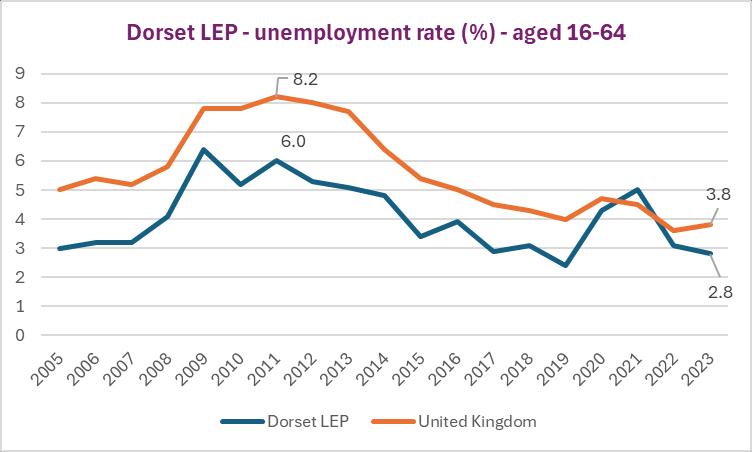
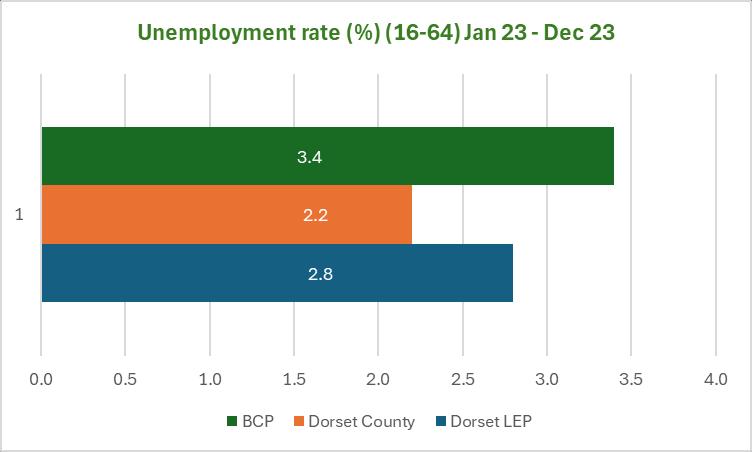
(Un)employment

• Both employment and unemployment rates in Dorset remain more favourable than the national averages (although the confidence intervals associated with the local data are wider).
• There were 8,500 more people employed in Dorset (LEP) at the end of 2023 when compared to same period in 2022. Unemployment was continuing to fall – although there are signs that it is beginning to increase slightly – although still low by historical standards (again noting the need for care around local data). Dorset
Dorset LEP UK


+ 8,500 more people in employment* (+1.6 ppt)

- 800 fewer people unemployed* (- 0.3 ppt) (- 0.2 ppt) (+ 0.2 ppt)


Charts of the quarter 1 - Local economic inactivity

• As with other areas, a good proportion of those aged 16-64 who are economically inactive are long-term sick (the largest contributory factor), with temporary sickness less of a factor.
• The scale and proportion of those who have chosen early retirement appears to have fallen since late 2022.
(LEP) inactivity by reason (000s) – Apr 19- Dec 23 (16-64)
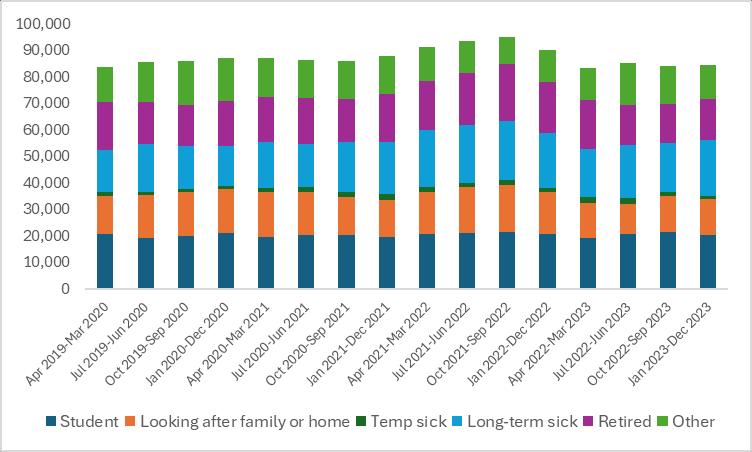

(LEP) inactivity by reason – Jan 23 – Dec 23 (16-64)
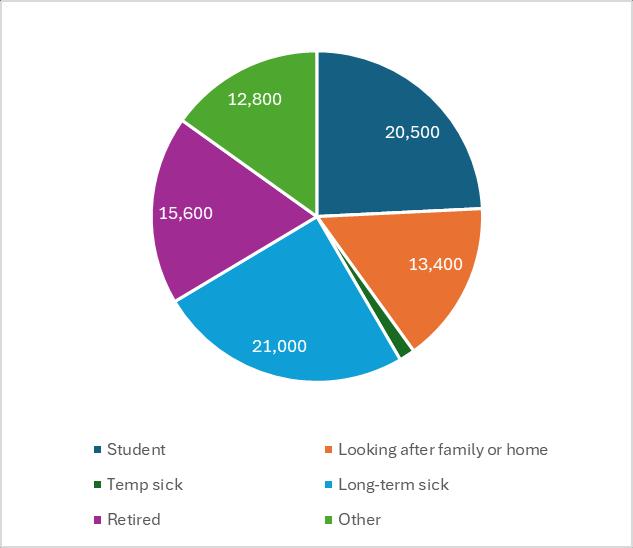
Dorset
Dorset
Charts of the quarter 2 - pay growth & job growth by age

• Average (nominal) pay has remained robust, although off the peaks seen through the latter part of 2023. Combined with inflation having fallen in recent months, this has resulted in real pay growth remaining robust.
• The increase in payrolled employees over the last 12 months has largely been driven by those aged 35+, with falls experienced in the younger age group.
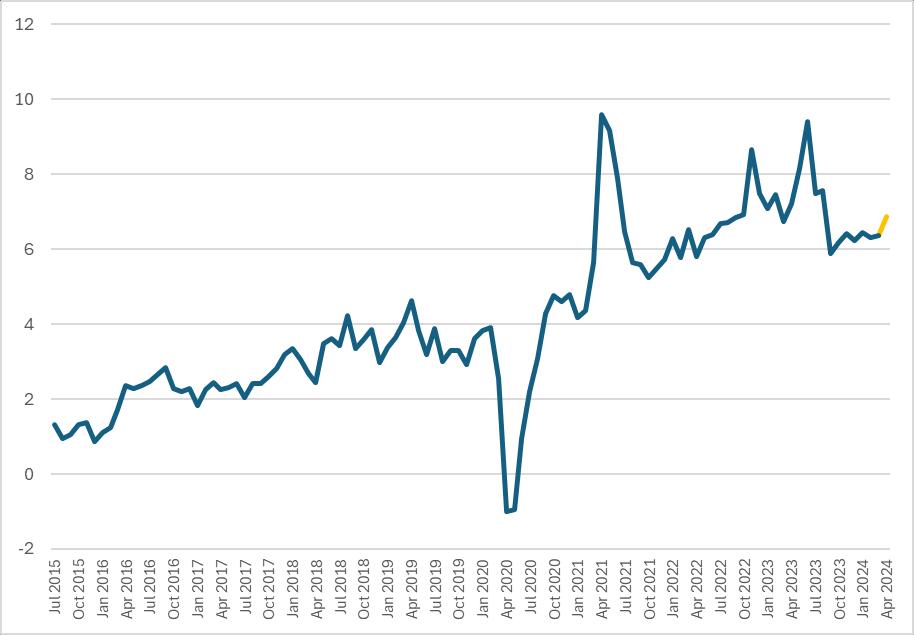

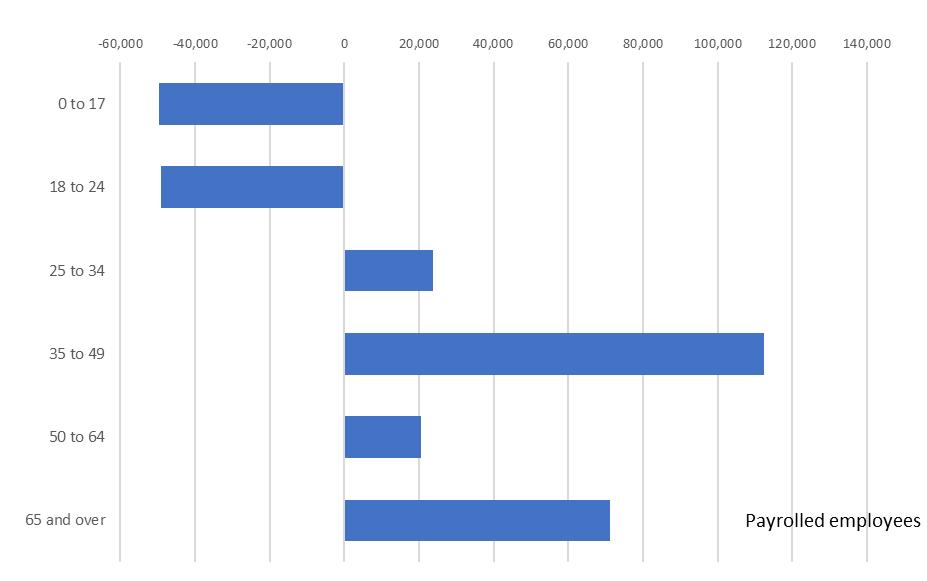
UK average (median) annual pay growth: July 15 – Apr 24
UK payrolled employees by age (Apr 24), absolute change from Apr 23
Claimants

• With some lag in employment figures, claimant counts over the 1st quarter of 2024 have broadly remained level in terms of the number of people on out-of-work benefits. This does not show the true extent of unemployment. Unemployment for younger people remains higher than the whole workforce.
Out of work benefits
Claimants as a proportion of residents aged 16+ 3.0%

Youth unemployment
Claimants as a proportion of residents aged 18-24
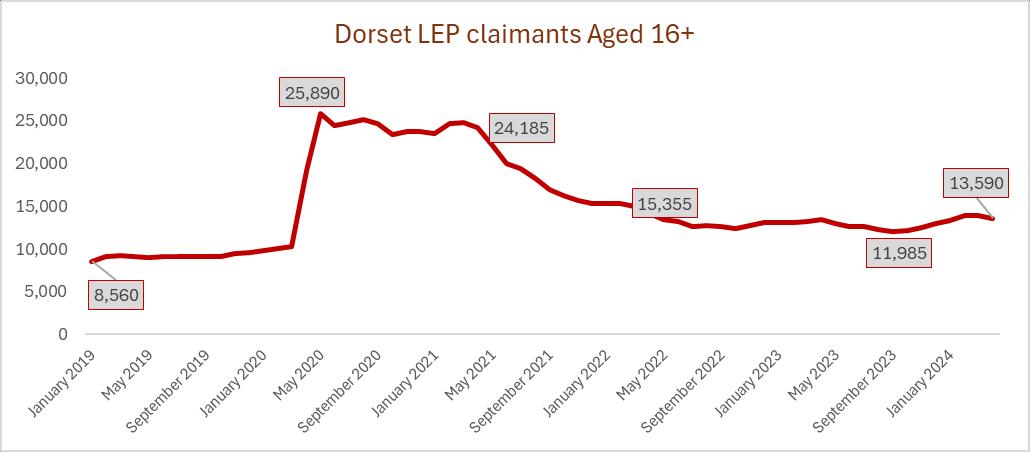
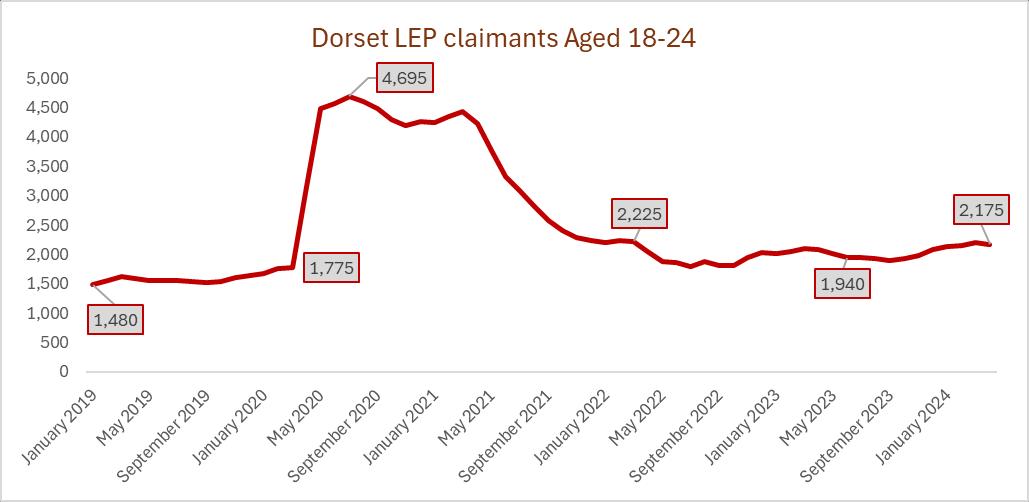
Salaries

• Whilst inflation may have begun to fall, there remains a focus on trends in wages/salaries given that household budgets remain under pressure. It is interesting to understand trends in salaries/wages being offered through advertised vacancies (noting this is a proportion of total jobs). The data suggests that average advertised wages (right-hand charts)have increased in both the medium-term and more recently. This data suggests that the average advertised salary (noting this can be influenced by the types of jobs sought) has risen steadily in the post-pandemic environment, more so in the last 12 months.
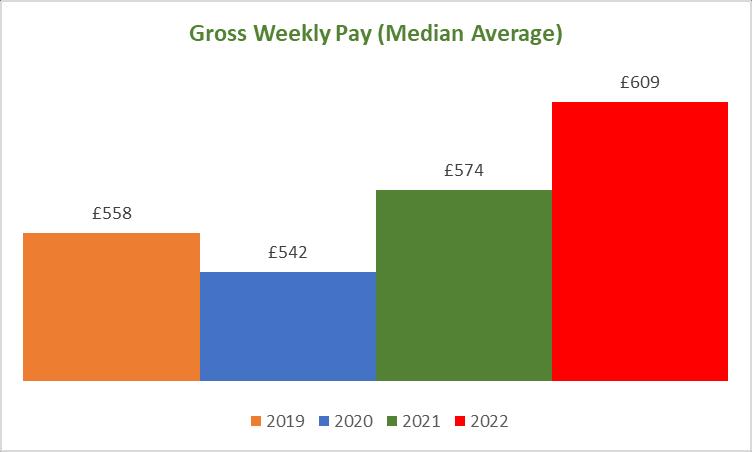

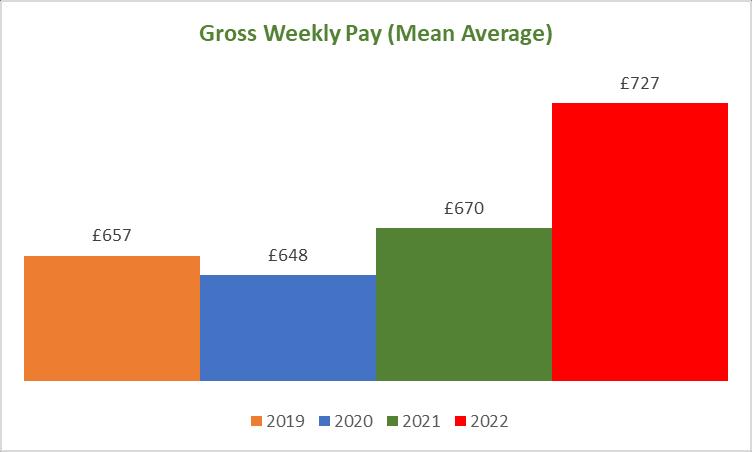
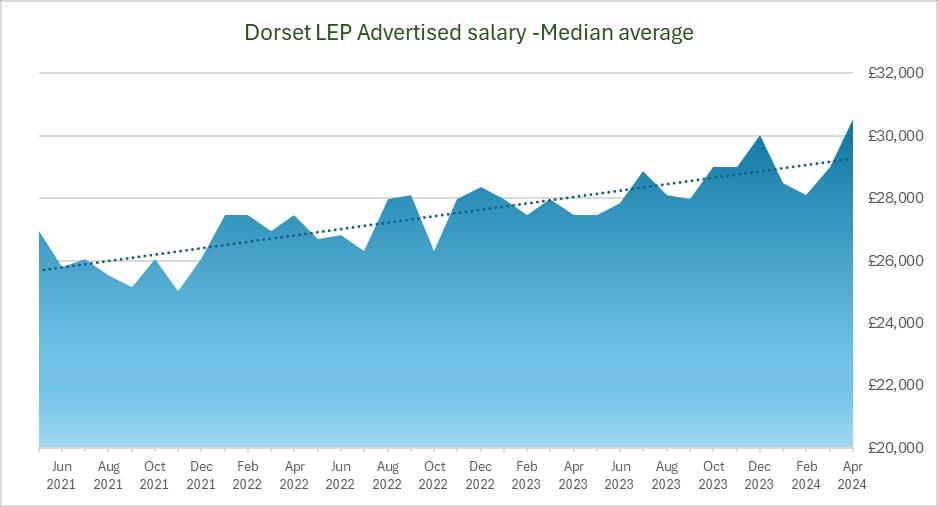
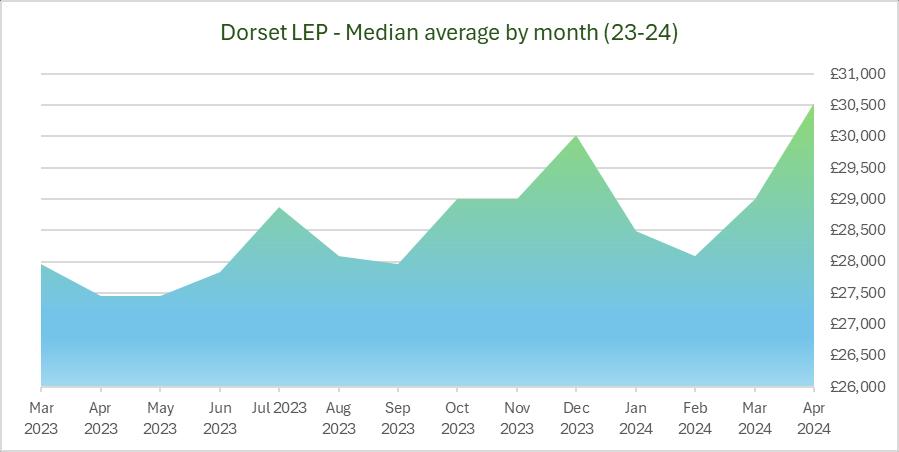

Salaries

• Many of the largest recruiting broad industries across Dorset are looking for roles that pay above the average advertised salary for Dorset (c£28.5k) (Mar 23-Apr 24), with others – such as food & drink and retail – below this average. Of those industries that pay the very highest average wages, only financial services had any significant scale in terms of recruitment over the past 12 months.
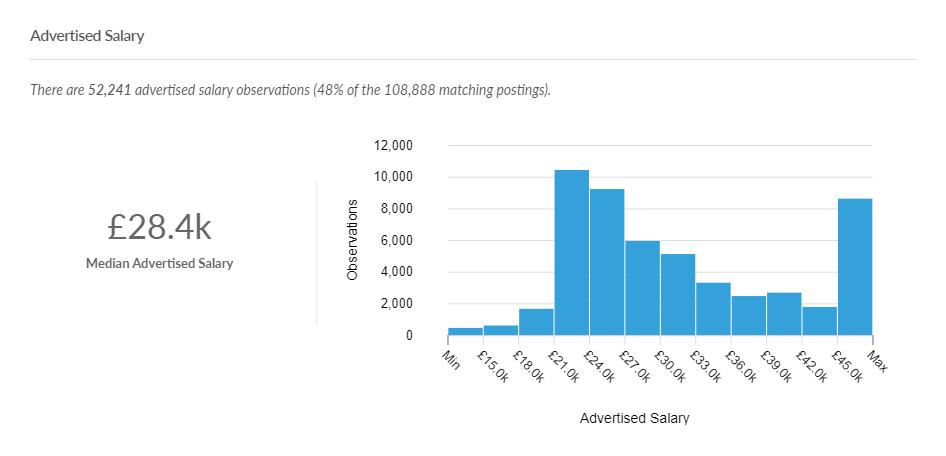

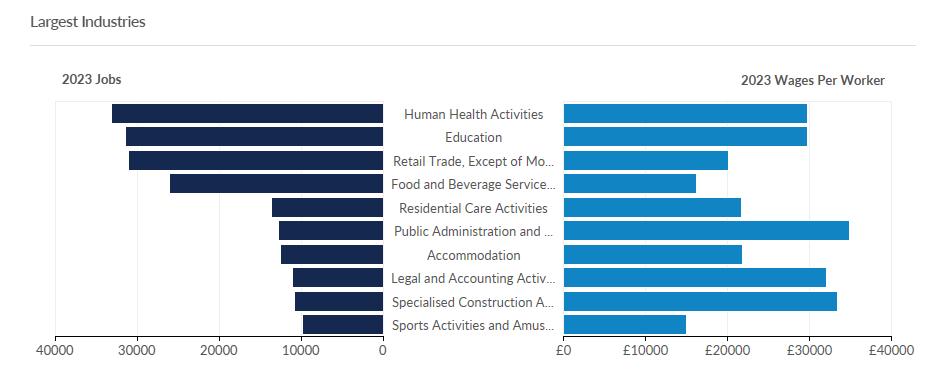
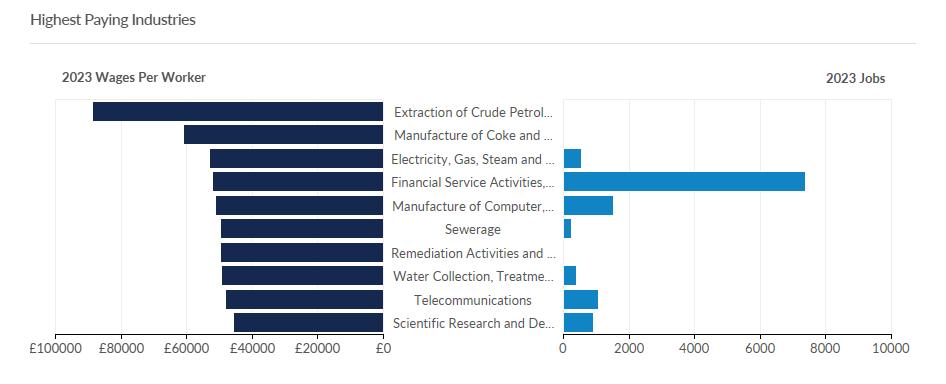

Dorset recruitment trends
• As is consistently the case, the NHS is by far the largest source of labour demand in Dorset – around 5 times as many as the second largest employer – Dorset Council (excluding recruitment agencies). The NHS and the care sector continues to face significant skills shortages and recruitment difficulties (as shown by average posting duration). Demand has also been high at local Councils, Haven Holidays, JP Morgan Chase, Tesco, and Bournemouth University. Much recruitment still flows through recruitment agencies.

• The Ministry of Justice was a significant recruiter over the past 12 months.
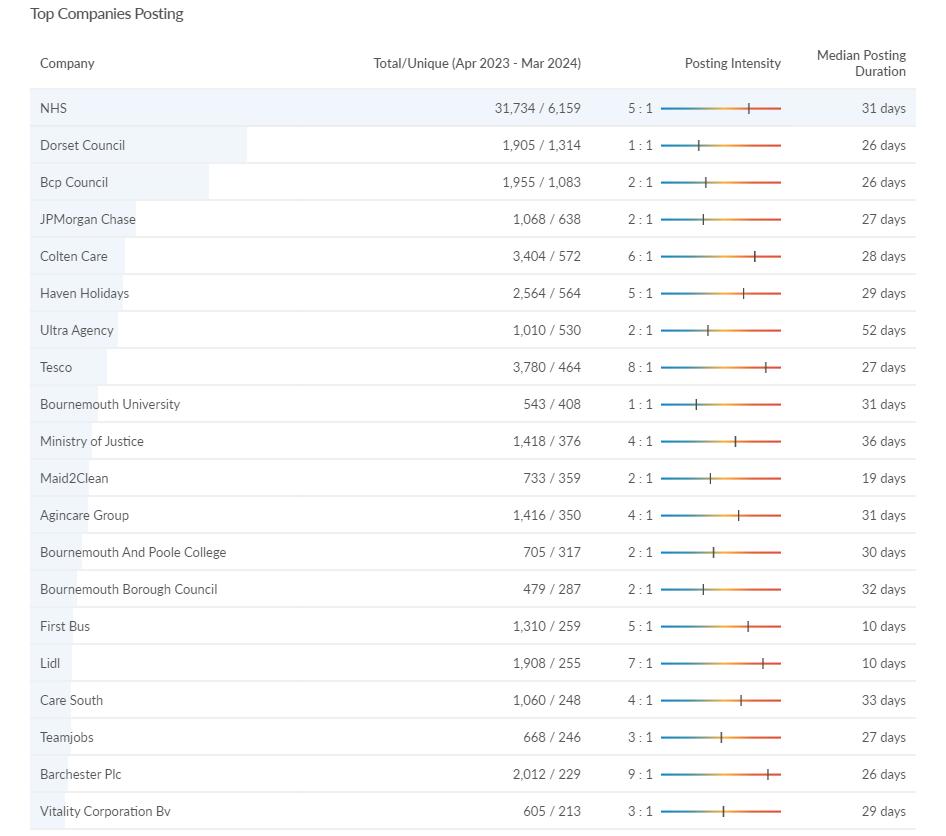


Industry demand trends in Dorset

• Looking at the industries with highest number of vacancies in the 4 months to April 24 the health care continued to dominate with the most significant unique postings – although lower than in the same period in 2023 and 2022. This appears to have also occurred in residential care – suggesting that 2022-2023 may have been a temporary peak in recruitment into the large health and care sector across Dorset.
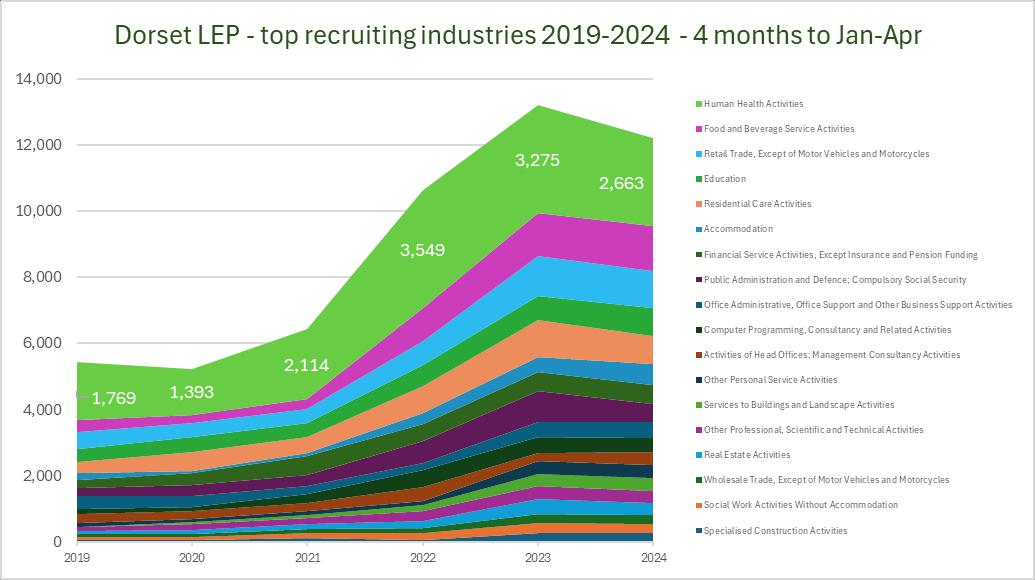


Industry demand trends in Dorset

• The data from Lightcast shows that a large proportion of advertised vacancies flow through ‘employment activities’ i.e. recruitment agencies. Therefore, it is not possible to get a full sector/industry picture because these recruitment agencies act as a conduit for a myriad of sectors – it is not possible to tell who is the ‘end recruiter’. Therefore, numbers of most sectors will be underplayed in the data.
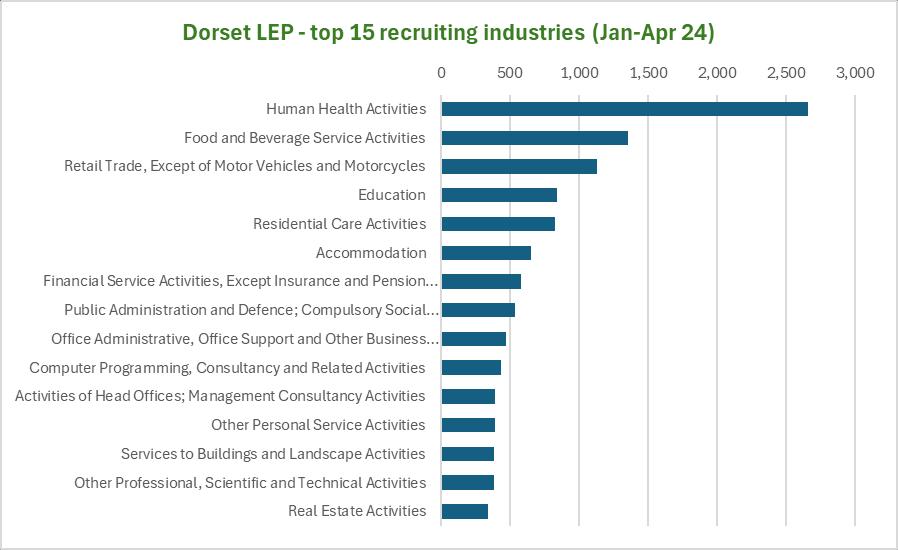

Top posting industries – Apr 23-Mar 24
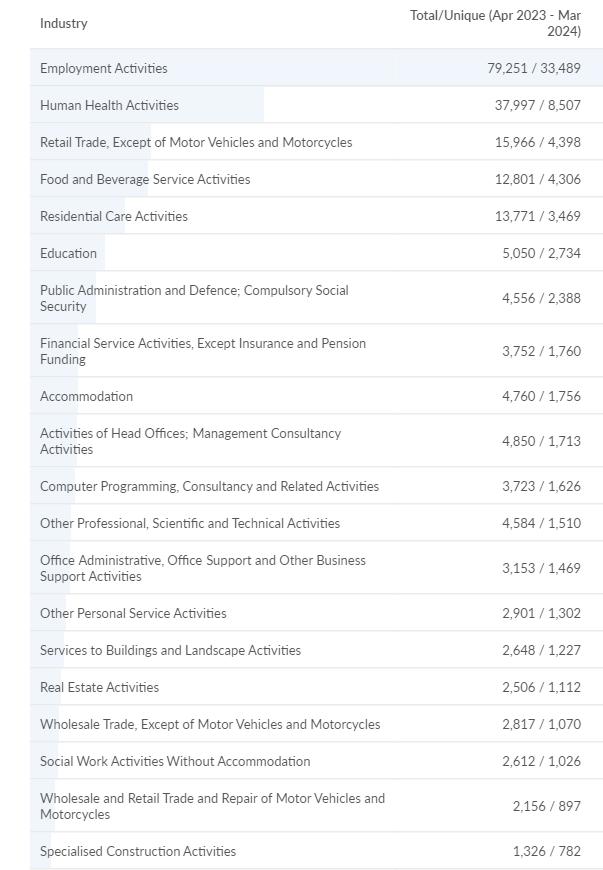

Top 12 industries (2024)
Vacancy growth in 2024 to date (Jan - Apr)

• Labour demand across all broad industries (using online advertised posts as a proxy) in Dorset has also grown considerably when compared to pre-pandemic levels (2019). This may be an indicator of changing recruitment practices, as well as stronger demand.
• As would be expected, growth is smaller when comparing (Jan-Apr) 2024 to the same period in 2023. As noted previously, demand has actually fallen in the health and care sector.
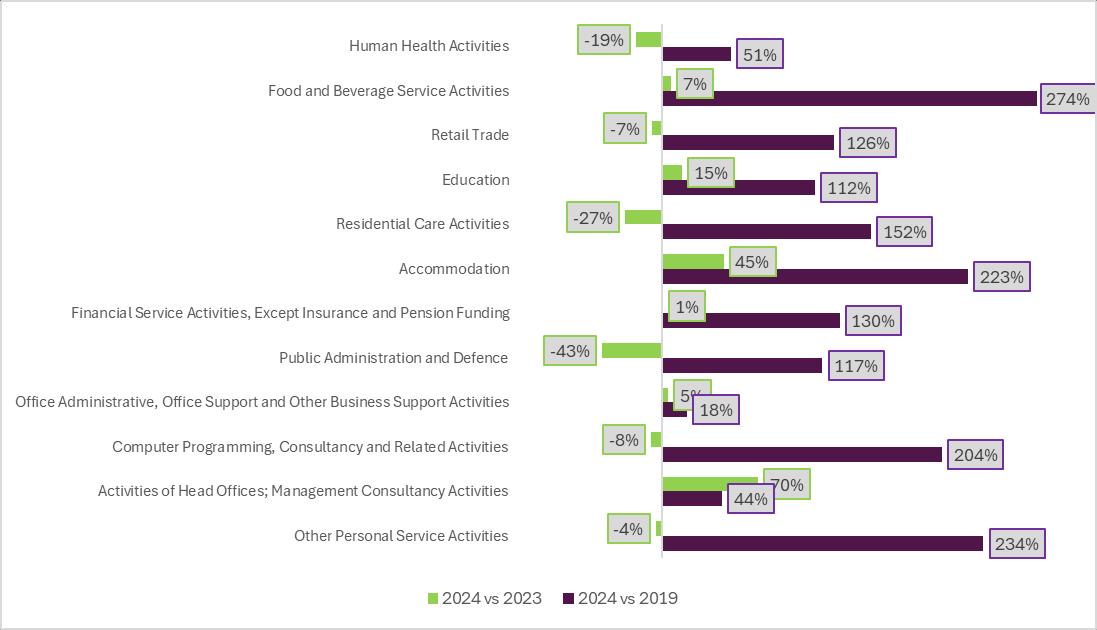


Vacancies by occupation

• The occupations with the highest demand across Dorset are consistently care workers and care home carers. However –as with the wider trend noted in previous slides around a fall demand in the health and care sector – this also appears to be occurring for specific roles. In the period Jan-Apr 24 the number of advertised roles for care workers and home carers has fallen from the highs seen in 2023. Conversely, the number of advertised roles for sales related occupations has increased quite markedly. Occupations
Jan
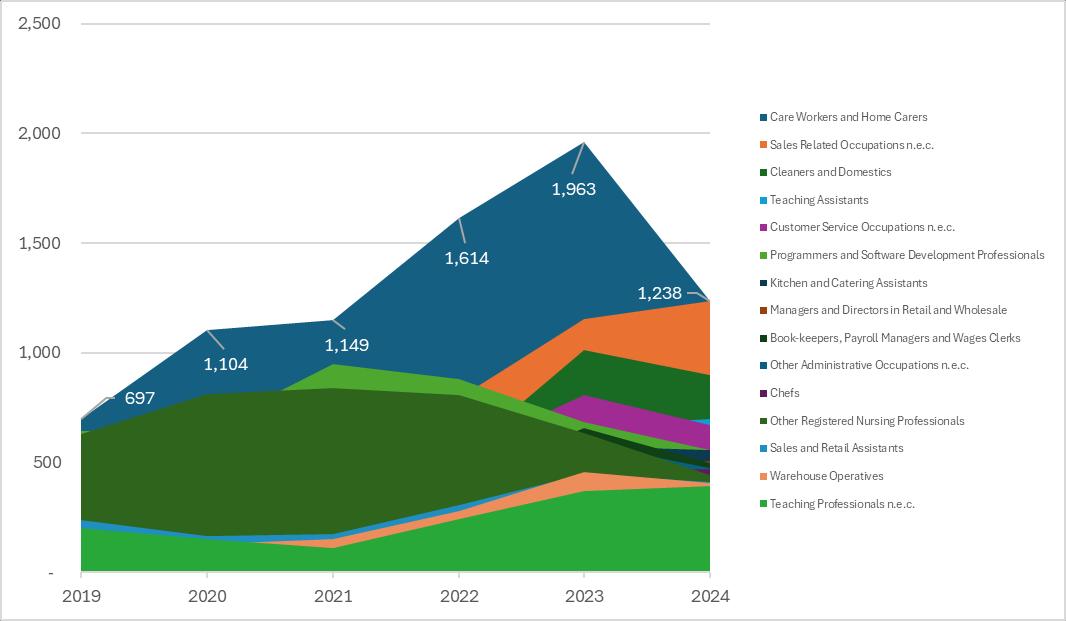

Jan - Apr 2024
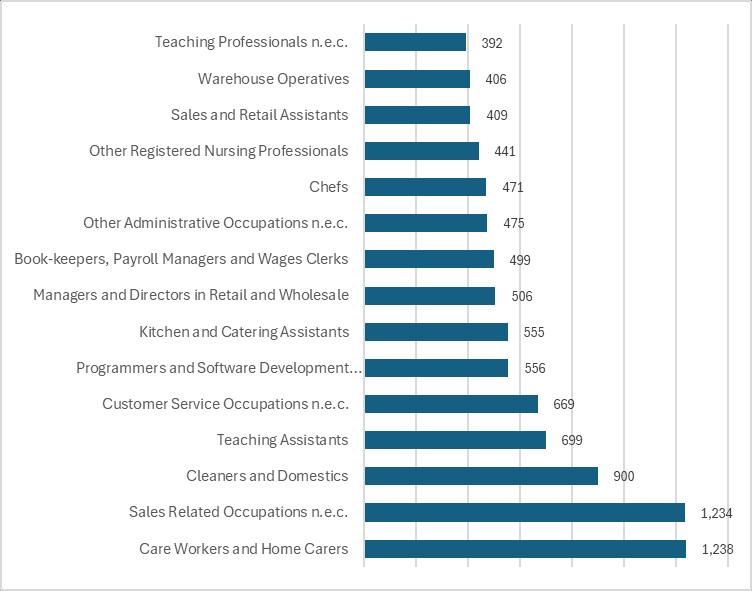

Posted jobs and employment by occupation
• Focusing on job titles rather occupational definitions, specific jobs that are most in demand include those associated with health and care, as well as other roles such as labourers, delivery drivers etc. In terms of broad occupation demand – the most prevalent occupation across Dorset are professional and associate occupations.

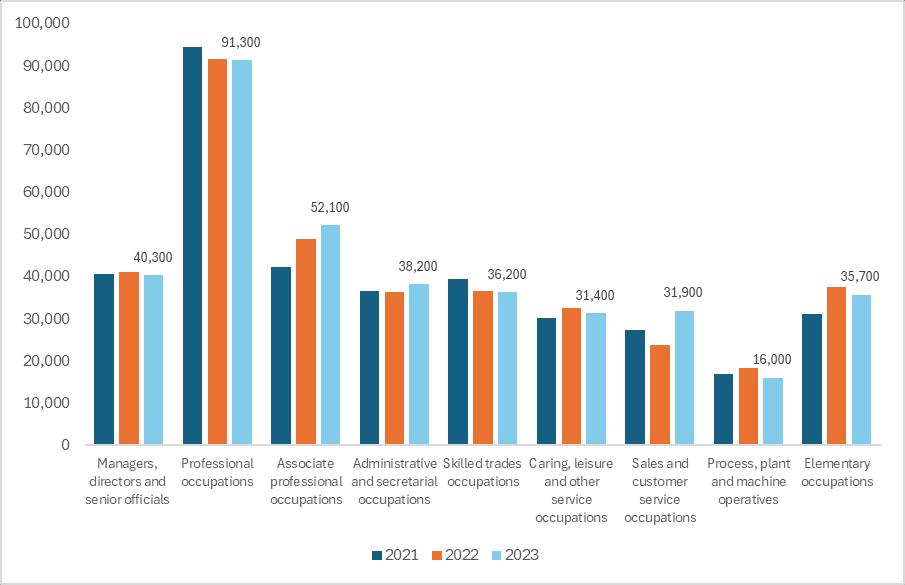

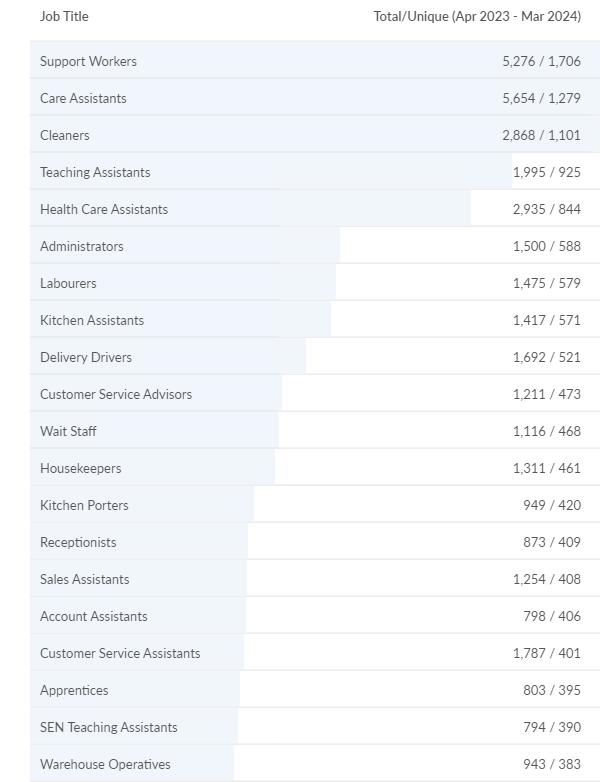
Dorset – employment by broad occupation (SOC 2020)
High skilled occupations in Dorset – 12 months to Apr 24
PROFESSIONALS
c29.2k unique job postings
Median advertised salary: c£37.6k Top roles: Nurses, Engineers, Programmers, Engineers, Teachers & Accountants

Top Sectors: Administrative, Health, Financial Services & Education
ASSOCIATE PROFESSIONALS
c10.7k unique job postings
Median advertised salary: c£27.5k
Top roles: Project Managers, Account Managers, Finance, Advertising & Marketing, Engineering
Top Sectors: Health, Education, Admin, Health, Retail, Real Estate

MANAGERS & DIRECTORS
c6.2k jobs unique job postings
Median advertised salary: c£30k
Top roles: Business Development Managers, Store Managers, Public Health Managers
Top Sectors: Admin, Health, Retail, Trade & Finance, Residential Care
Top employers: NHS, Teaching Personnel, Prospero Teaching, JP Morgan Chase, Councils, Dorset Council, Ultra Group, Vitality
Top skills: Communications, Management, Teaching, Leadership, Planning
Top employers: NHS, Ministry of Justice, JP Morgan Chase, Councils, BU, Holt Engineering, Tops Day Nurseries
Top employers: NHS, Tesco, JP Morgan Chase, Lidl, Councils, Haven Holidays, Agincare, Holt
Top skills: Communications, Customer service, Sales, Detail Orientation
Top skills: Management, Communications, Customer Services


• Employers most frequently requested soft skills were in communication, customer service, management, sales, and detailorientation, alongside personal attributes such as enthusiasm and self-motivation. Specialised skills often cited in job postings include auditing, and project management. This continues longer-term trends.
• Many of these were less prevalent in candidate profiles (i.e. CVs) when compared to the volume of references in job postings (recognising that skill sets may not be accurately described in candidate profiles).
Top sought after skills (job postings) – Dorset LEP area Mar 23 – Apr 24
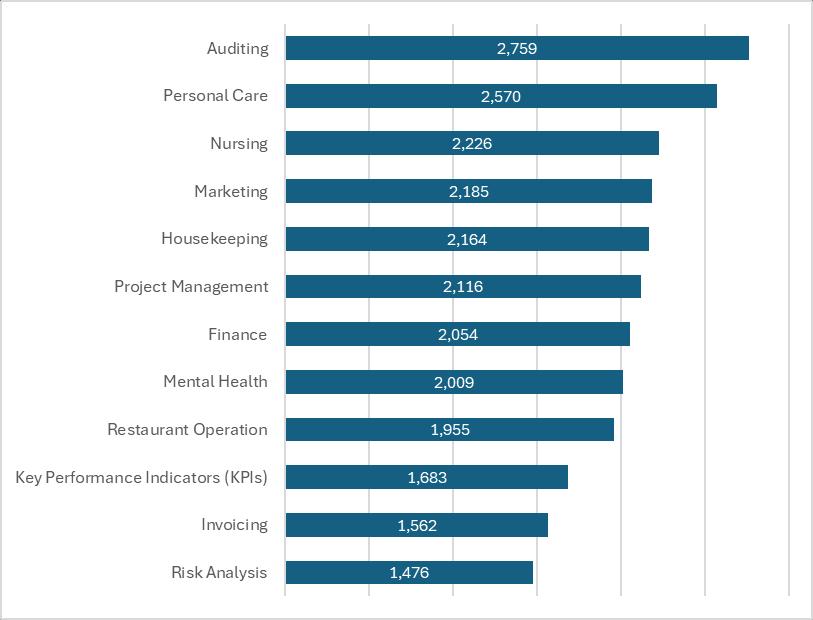

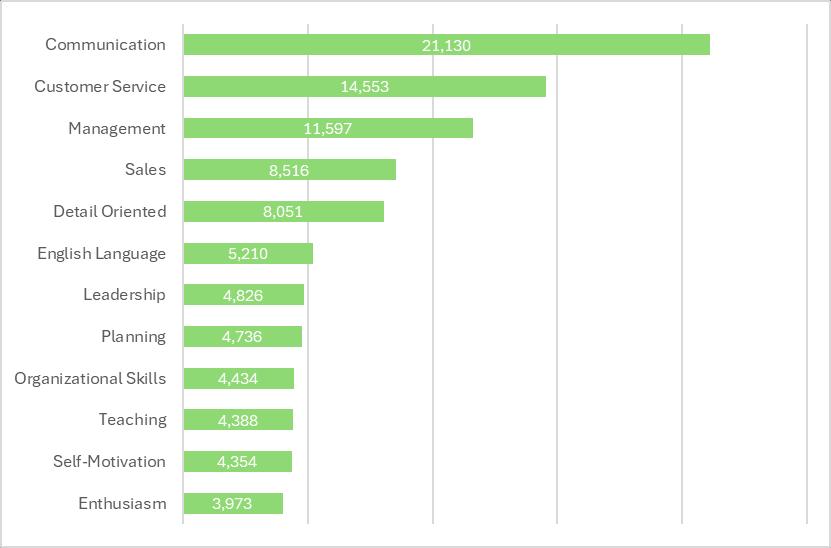

Specialised skills
Common skills
Hard to fill roles
• The most difficult-to-fill roles in the last 12 months (as defined as the longest average posting duration) covers a range of different jobs, with no particular pattern or specific to any industry. The average posting duration for all job postings across Dorset was 29 days over this period, with the average (median) advertised salary of c £28,500. Some of the hard-to-fill roles are offering higher than average salaries, whilst others are below this.

Most hard-to-fill roles by average posting duration*
Dorset LEP area Mar 23 – Apr 24

Education & Experience - Mar 2023 to Apr 24
• Only 28% of advertised jobs specified experience requirements in terms of number of years. Where specified, two-thirds of the advertised jobs required less than 3 years of experience.
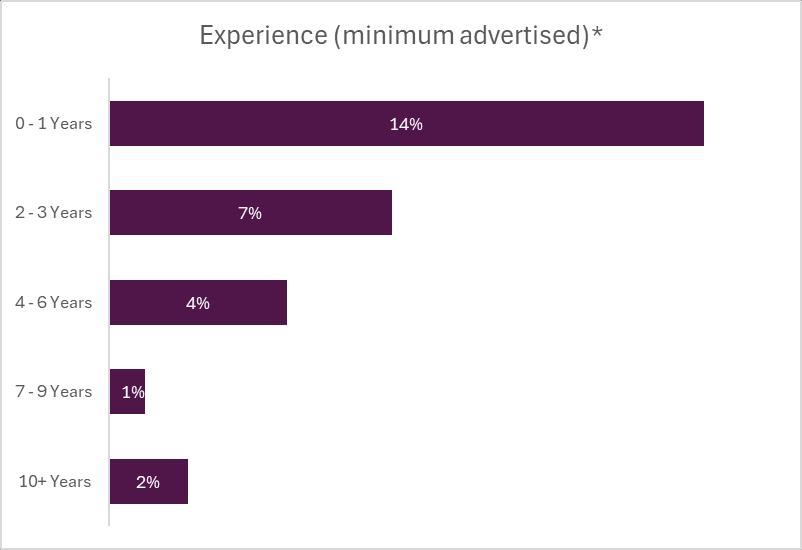

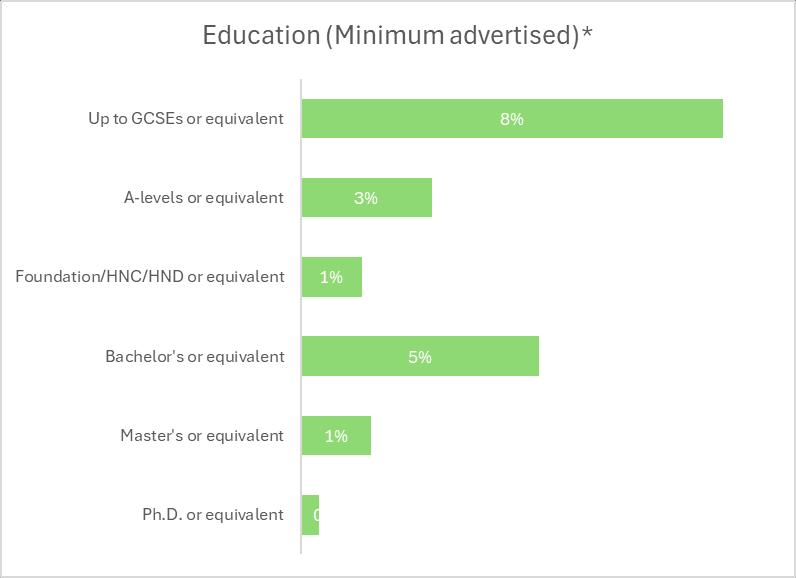
• Only 18% of advertised jobs specified educational requirements. Where specified, around a third specified a minimum requirement of a degree or above. This is lower than seen historically, with a greater proportion indicating a minimum requirement of GCSEs or equivalent



Graphs only slides


The labour market – UK vacancies and jobs




Signs of softening – Dorset




A fall in quarterly demand



8,909 BCP
14,925 Q1 2024 vs Q1 2023

Unemployment remains low – for now




(Un)employment
Dorset LEP UK




Dorset LEP UK


Charts of the quarter 1 - Local economic inactivity

(LEP) inactivity by reason (000s) – Apr 19- Dec 23 (16-64)


Dorset (LEP) inactivity by reason – Jan 23 – Dec 23 (16-64)

Dorset
Charts of the quarter 2 - pay growth & job growth by age
UK average (median) annual pay growth: July 15 – Apr 24



UK payrolled employees by age (Apr 24), absolute change from Apr 23

Claimants




Out of work benefits
Claimants as a proportion of residents aged 16+ 3.0%
Youth unemployment
Claimants as a proportion of residents aged 18-24 3.5%
















Dorset recruitment trends




Industry demand trends in Dorset




Industry demand trends in Dorset




Industry demand trends in Dorset
Top posting industries – Apr 23-Mar 24




Top 12 industries (2024)




Vacancies by occupation
Occupations
Jan - Apr 2024



Top Occupations – top 15 occupations - long-term developments
Jan - Apr 2024


Posted jobs and employment by occupation




Dorset – employment by broad occupation (SOC 2020)
High skilled occupations in Dorset – 12 months to Apr 24
PROFESSIONALS
c29.2k unique job postings
Median advertised salary: c£37.6k Top roles: Nurses, Engineers, Programmers, Engineers, Teachers & Accountants

Top Sectors: Administrative, Health, Financial Services & Education
ASSOCIATE PROFESSIONALS
c10.7k unique job postings
Median advertised salary: c£27.5k
Top roles: Project Managers, Account Managers, Finance, Advertising & Marketing, Engineering
Top Sectors: Health, Education, Admin, Health, Retail, Real Estate

MANAGERS & DIRECTORS
c6.2k jobs unique job postings
Median advertised salary: c£30k
Top roles: Business Development Managers, Store Managers, Public Health Managers
Top Sectors: Admin, Health, Retail, Trade & Finance, Residential Care
Top employers: NHS, Teaching Personnel, Prospero Teaching, JP Morgan Chase, Councils, Dorset Council, Ultra Group, Vitality
Top skills: Communications, Management, Teaching, Leadership, Planning
Top employers: NHS, Ministry of Justice, JP Morgan Chase, Councils, BU, Holt Engineering, Tops Day Nurseries
Top employers: NHS, Tesco, JP Morgan Chase, Lidl, Councils, Haven Holidays, Agincare, Holt
Top skills: Communications, Customer service, Sales, Detail Orientation
Top skills: Management, Communications, Customer Services

Skills





Top sought after skills (job postings) – Dorset LEP area Mar 23 – Apr 24
Hard to fill roles


Education & Experience - Mar 2023 to Apr 24




